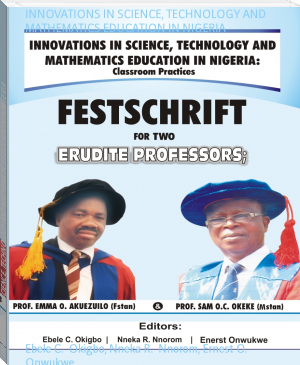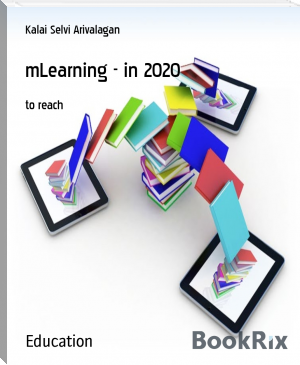INNOVATIONS IN SCIENCE, TECHNOLOGY AND MATHEMATICS EDUCATION IN NIGERIA, Ebele C. Okigbo, Nneka R. Nnorom, Ernest O. Onwukwe [best reads .TXT] 📗

- Author: Ebele C. Okigbo, Nneka R. Nnorom, Ernest O. Onwukwe
Book online «INNOVATIONS IN SCIENCE, TECHNOLOGY AND MATHEMATICS EDUCATION IN NIGERIA, Ebele C. Okigbo, Nneka R. Nnorom, Ernest O. Onwukwe [best reads .TXT] 📗». Author Ebele C. Okigbo, Nneka R. Nnorom, Ernest O. Onwukwe
The population of senior secondary class two (SS2) students of Alvana Model Secondary School for the academic sessions of 2012/2013, 2013/2014, 2014/2015 and 2015/2016 summed up to 1,400.The population of the study is therefore 1,400. The sample was drawn from SS2 students who offered Animal Husbandry between 2012 to 2016, totaling,492.
Project Work Intervention Strategy
The treatment procedure for the project work intervention strategy consisted of providing an opportunity for SS2 students to offer Animal Husbandry as a trade subject with varying number of specific projects for the students over a four-year period of time. In the first year, Animal Husbandry together with other trade subjects like tie and dye, catering, garment making, data processing and so on were provided for students to choose from and enroll for classes.
The first group of students that enrolled for Animal Husbandry in 2012/2013 session were taught this subject without any specific project throughout the session. They wrote terminal examinations in the subject and their average cumulative scores calculated. These students formed the control group for this study.
In the second, third and fourth years, the same provisions and opportunities were made for SS2 students expect that students were required to participate actively in specific group projects. These specific group projects were being increased in number and type over the period of time as follows:
One specific project of poultry keeping group.
Two specific projects of poultry and rabbit keeping group.
Three specific projects of poultry, rabbit keeping and fishery group.
The activities of the specific projects comprised of
Choosing and planning for the specific project
Construction of the cages/pens and ponds required to raise the livestock with expert advice and assistance.
Market surveys for the items required
Purchases of the items required
Drawing of the time table and apportioning duties to individuals/groups of students
Monitoring of the duty roster.
Advertising and marketing of stock.
Some of the specific projects spilled over holidays and even beyond a particular term. In spite of these extended times, the students were encouraged to observe their duties as a lapse in responsibility could jeopardize the entire project. Every participating student got some slots of duty for weekends or holidays. Normal class lessons by the same subject teacher held throughout the duration of this research.
Administration of test
For this case study, normal termly examinations according to school time table which stipulate done-week revision of work before written class examinations. This was done termly for three terms in each session. Examination tests were teacher made and guided by the national syllabus on Animal Husbandry which tested students’ overall performance according to the termly scheme of work. Academic achievement observational schedule was constructed in which was recorded students’ enrolment and examination results termly. Achievements were summarized as SS2 cumulative percentage score. The test instruments were not validated neither was their reliability indices calculated.
Data Analysis
The main data collected in this study were achievement scores and enrolment figures. The research questions were answered using means and standard deviations and proportions while the hypotheses were tested with Analysis of Covariance (ANCOVA).
Results
H01: There is no significance difference in the mean achievement scores in Animal Husbandry of SS 2 students who carried out specific projects and those who did not.
Table 1: Summary of t-test on specific and non-specific projects in Animal Husbandry achievement scores of students
Project Group N Mean SD T Df P-value Decision
No SPG 79 49.50 15.34 18.650 416 0.000
Reject Ho
SPG 339 78.66 11.77
Total 418
From the results in Table 1, the alternative hypothesis is retained thus: There is significance difference in the mean achievement scores in Animal Husbandry of SS 2 students who carried out specific projects and those who did not.
H02: There is no significant difference in the mean achievement scores in Animal Husbandry of SS 2 students who carried out three, two and one specific projects during the session.
Table 2:Mean scores of different Numbers of specific project groups.
Project Group N Mean Standard Deviation
One SPG 85 77.2141 11.10452
Two SPG 150 78.6580 13.11584
Three SPG 104 79.8452 10.09518
Total 339
Table 3: Summary of ANOVA on Mean scores of different Numbers of specific project.
Scores
Sum of Squares df Mean Square F Sig.
Between Groups 323.786 2 161.893 1.170 .312
Within Groups 46486.826 336 138.354
Total 46810.612 338
From the results of the ANOVA as shown in Table 3, the statement of hypothesis 2is accepted; implying that the small differences observed in mean values as number of specific projects increased is not significant at 0.05 significant level.
H03: There is no significant difference in enrollment figures of male and female SS2 students in Animal Husbandry when three, two and one specific projects are provided students
Table 4: contingency table on gender and enrollment of students in different numbers of specific projects
Enrollment
Gender No SPG 1 SPG 2SPG 3SPG Total
Male 52 55 99 62 268
Female 27 30 51 42 150
Total 79 85 150 104 418
Table 5:Summary of Chi-square test of independence on gender and specific projects
Value Df Asymp. Sig (2-Sided)
Pearson Chi-Square 1.260a 3 .739
Likelihood Ratio 1.247 3 .742
Linear-by-Linear Association .587 1 .444
N of Valid Cases 418
The results show the summary of Chi-square test of independence on gender and specific projects in Animal Husbandry. Since the p-value (0.739) is greater than our chosen significance level (0.05), we do not reject hypothesis 3. Rather, we conclude that there is no enough evidence to suggest an association between gender and enrollment of students in more specific projects in Animal Husbandry. Based on the results, we can state that no association was found between gender and enrollment of students in more specific projects ().
Conclusions and implications of the findings
Experiential teaching and learning strategies such as project enhanced secondary school students’ achievements in Animal Husbandry specifically and generally in all some other areas of their performance in the case studied. This is in line with literature viewed, especially Gill (2016) and Cakici and Turkmen (2013) who related project works to knowledge making through previous experience. According to Muriithi, Odundo, Origa and Gatumu (2013) project approach to teaching and learning creates the enabling environment for collaboration between students and teacher. Effective collaboration between teacher and student can only lead meaningful development where everyone is a winner.
Over stretching a particular strategy, especially project works, may kill motivation of students to enroll in science and technology subjects like Animal Husbandry. Entrepreneurial education can leverage on project teaching and learning methods as well as on trade subjects to re-orientate the minds and the practice of teachers and students towards ‘education for relevance maxim’
This study may have been limited by the case study design which may limit the generalization of the findings. Further studies could be carried out in the areas of factors limiting the implementation of entrepreneurial education strategies in schools.
Recommendations
Some of the recommendations emanating from the findings of this study include but may not be limited to the following:
Entrepreneurial education as proposed by education reforms of the 1990s should be adopted by the secondary school system.
Students’ specific project works and the trade subjects should be used to drive it in a real practical way.
References
Abonyi, O.S., & Okoli, B. (2009) Entrepreneurial skills through STM education and the emerging challenges of Needs. In Udofia, N.A. (Ed) STAN50th Annual Conference Proceed, 21-25. HEBN Pub. Plc.
Benhrendt, M. & Frankline, T., (2014) A review of literature on School field trips and their values in education. Internal Journal of Environmental and Science Education, 9, 235-245.
Cakici, Y. & Turkmen, N., (2013) an investigation of het effects of projects-based learning approach on children’s achievement and attitude in science. On-line Journal and Technology,3(2); 9-17.
Forest, C. (2004) Kolb’s learning cycle train the trainer issue 12. http://www.structuredlearning.com
Grant, M.M., (2002) Getting a grip on Project-Based Learning: Theory cases and recommendations. Middle school computer technologies Journal, 5:1Winter, 1-3.
Gill, M., (2014). Project Method of Teaching
Mandeep, G. (2014) Project method of teaching www.slideshare.net/mandeepGrill1/project-method-of-teaching Retrieved 27th October, 2016.
Kenna, J., (2014) Teachers’ utilization of field trips: A Comparative study. University of Floride Libraries http://library.ucf.edu.
Michelson, E., (1996) usual suspects: experience, Reflection and the (en) gendering of knowledge. International Journal of lifelong Education, 15 (6); 438-454.
Muriithi, E.M., Odundu, P.A., Origa, J.O., & Gatumu, J.C., (2013) Project method and Learner Achievement in physics in Keynan Secondary Schools. International Journal of Education and Research, 1 (7); 1-12.
Nnachi, R.O., (2010) Psychological strategies for fostering entrepreneurship in science education: the Global Perspective. International Journal of Educational Research, 10(3); 33-45.
Onwukwe, C.M., Onwukwe, E.O., & Nwaeze, E.U.C,. (2011) Encouraging Entrepreneurship through student’s project works. Alvana Journal of Science, 5(1); 164-171.
Onwukwe, E.O., & Agommuoh, P.C., (2016) Science and Technology Education: A veritable tool for Peace, Conflict Resolution and National Development. IOSR Journal of Research & Method in Education (IOSR-JRME), 6(4); 1 July-Aug. 2016. 87-42.
Person Education Limited (2003). Longman Dictionary contemporary English. Edibur: Longman Plc.
Roessingh, H. & Chambers, W., (2011) Project –based learning and Radagogy in teacher preparation: staking out the theoretical mid-ground. International Journal of Teaching and Learning in Higher Education, 23(1); 60-71.
Uchenna, C., (2011) Re-branding in Science & Technology Education and vision 20-20-20: Implication for National Development. Journal of Nigerian society for Psychical Research, 3(1);195-203.
THE NEED FOR ENHANCING AND PROMOTING SCIENCE, TECHNOLOGY AND MATHEMATICS EDUCATION (STEM) FOR SUSTAINABILITY AND PROGRESS IN NIGERIA
Ahmed Wudil Aminu
&
Adamu Rabiu
Abstract
This article focused on the identification of possible strategies of promoting science and technology education programs for enhanced service delivery in developing enterprises in Nigeria. Science Education has been identified as a key to national development in diverse sectors of the nations of the world, Nigeria, inclusive. It is on this premise that the teaching and learning of Science Education is giving a priority, focus and attention in terms of its implementation strategies. Science and technology has employed numerous strategies to promote the development of enterprises to ensure that the rising number of unemployed youths and economically productive adult population are gainfully engaged in meaningful national development. This theoretical article evaluates the meaning and concept of science and technology education, the need for it, and its relationship with politics in national development and survival of man, as well as the strategies for implementation and the benefits. The paper recommends among others, that adequate instructional materials for the teaching science and technology education should be made available to give room for more practical classes than theory, which should be adequately supervised. More professional teachers in science and technology should be employed and government should make provision for improved funding for science and technology education. It concludes that science and technology has helped citizens in modern times to have faith in their ability to feed and defend themselves.
Keywords: Science education, National development, Political advancement, Sustainability.
Introduction
Science Education is an impetus to development in the several sectors of the nations of the world, particularly in Medicine, Engineering, Aviation, Agriculture, Technology, Telecommunication and many other areas. Perhaps, this serves as a rationale for making the discipline a priority at all levels of education, globally and considering the fact that, economy of most nations depends largely on progress and advancement made in Science Education. Kola (2013) avers that Science Education deals with sharing of science contents and processes with individuals, who are not considered traditionally to be a member of the scientific community. Tolu and Abe (2006) affirms that for any nation, including; Nigeria to attain sustainable development, there is a need to recognize Science. Therefore, Science Education becomes an aspect or a field of study that has attracted a great attention, globally and especially among the developing countries, pre-dominantly in African and some nations in Asian continents and Latin America in the 21st Century.
In Nigeria, a significant positive and encouraging progress has not been achieved on Science Education after many years of the nation’s independence (Rogan, 2003). This implies that, despite the attention, priority and focus of Science Education, the expected and desirable results are yet to attain and this has negative effects





Comments (0)